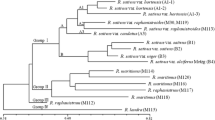Abstract
Determination of intraspecific genetic diversity is an important first step for the utilization of genetic resources and canprovide useful information on crop evolution. A living collection of Italian and foreign artichoke varieties and ecotypes is maintained at the Germplasm Institute, Bari, Italy. A total of 32 accessions of cultivated (Cynara cardunculus L. var.scolymus (L.) Fiori), three of wild (Cynara cardunculus var.cardunculus L.) artichoke and two ofcultivated cardoon (Cynara cardunculus var.altilis L.) were analysed in order to studygenetic variation and relationships within the species, using RAPDmarkers. Cultivated accessions were selected according tomorphological variation and geographical distribution available inthe collection. Fifty arbitrary decamer primers were initially tested, 18 ofwhich showed from 3 to 10 unambiguously interpretable fragments. Anintra-accession analysis using 4 varieties and 8 polymorphicprimers revealed that no RAPD variation was detected amongindividuals. Jaccard's similarity index (JSI) was comprisedamong 1 and 0.693 when all accessions were considered, on the otherhand, within the cultivated artichoke, JSI ranged between 1 and0.817. A UPGMA dendrogram based on the similarity matrix showed thatwild artichokes were clearly separated from cultivated accessions.Moreover, within cultivated artichokes, several groups could bedistinguished.
Similar content being viewed by others
References
Barbieri R. 1959. Osservazioni sulla biologia del carciofo ‘Spinoso Sardo’ (Cynara cardunculus L. scolymus L.). ‘Studi Sass., Ann. Fac. Agr.’ III (in Italian) 7: 19–36.
Basnizki J. and Zohary D. 1994. Breeding of seed-planted artichoke. Plant Breed. Reviews 12: 253–269.
Bianco V.V. 1990. Carciofo (Cynara scolymus L.). In: Bianco V.V. and Rimpini F. (eds), Orticoltura. Patron Editore, Bologna (in Italian), pp. 209–251.
Caneva G., Pontrandolfi M.A. and Fascetti S. 1997. Piante alimentari spontanee della Basilicata. In: Consiglio Regionale della Basilicata. Ufficio Stampa (in Italian), pp. 190–191.
Dellacecca V. 1990. Cardo (Cynara cardunculus L.). In: Bianco V.V. and Rimpini F. (eds), Orticoltura. Patron Editore, Bologna (in Italian), pp. 252–258.
Dellacecca V.V., Magnifico V., Marzi V., Porceddu E. and Scarascia Mugnozza G.T. 1976. Contributo alla conoscenza delle varieta di carciofo coltivate nel mondo Proceed. Internat. Congress on Artichoke, Bari 1973. Minerva Medica, Torino (in Italian), pp. 199–316.
De Vos N.E. 1986. Field improvement through single-plant selection in globe artichoke (Cynara scolymus L.) ‘Green Globe’. HortScience 21: 662.
Elia A. and Miccolis V. 1996. Relationships among 104 artichoke (Cynara scolymus L.) accessions using cluster analysis. Adv. Hort. Sci. 10: 158–162.
Figliuolo G. and Spagnoletti Zeuli P.L. 1994. Utilizzo di marcatori molecolari nella stima della diversita genetica di Aegilops geniculata Roth. Quad. Bot. Ambientale Appl. 4 (in Italian): 113–121.
Foury C. 1989. Ressources genetiques et diversification de l'arti chaut (Cynara scolymus L.). Acta Horticulturae 242: 155–166.
Francisco-Ortega J., Newbury H.J. and Ford Lloyd B.V. 1993. Numerical analysis of RAPD data highlight the origin of the cultivated tagasaste (Chamaecytisus proliferus ssp.palmensis) in the Canary Islands. Theor. Appl. Genet. 87: 264–270.
Hammouda R.M., ScifEl-Nasr M.M., Ismail S.I. and Shahat A.A. 1993. Quantitative determination of the active constituents in Egyptian cultivated Cynara scolymus. Intl. J. Pharmacog. 31: 299–304.
Hanelt P. 1986. Pathways of domestication with regard to crop types (grain legumes, vegetables). In: Barigozzi C. (ed.), The Origin and Domestication of Cultivated Plants. Elsevier, Amsterdam, pp. 179–199.
Maggini F., Tucci G.F. and Gelati M.T. 1988. Ribosomal RNA genes in species of the Cynareae tribe (Compositae). II. Protoplasma 144: 125–131.
Miccolis V., Bianco V.V., Elia A., Perrino P. and Volpe N. 1989. Valutazione della collezione mediterranea di carciofo allevata nella valle dell'Ofanto. L'Informatore Agrario 45 (in Italian): 35–41.
Paz M.M. and Veilleux R.E. 1997. Genetic diversity based on randomly amplified polymorphic DNA (RAPD) and its relation-ship with the performance of diploid potato hybrids. J. Amer. Soc. Hort. Sci. 122: 740–747.
Porceddu E., Dellacecca V. and Bianco V.V. 1976. Classificazione numerica di cultivar di carciofo Proceed. II Internat. Congress on Artichoke, Bari 1973. Minerva Medica, Torino (in Italian).
Rohlf F.J. 1993. NTSYS-pc. Numerical Taxonomy and Multi-variate Analysis System. Exeter Software, Setauket, NY, Version 1.80.
Rottenberg A. and Zohary D. 1996. The wild ancestry of the cultivated artichoke. Genet. Resour. Crop Evol. 43: 53–58.
Rottenberg A., Zohary D. and Nevo E. 1996. Isozyme relation-ships between cultivated artichoke and the wild relatives. Genet. Resour. Crop Evol. 43: 59–62.
Sonnante G., Spinosa A., Marangi A. and Pignone D. 1997. Isozyme and RAPD analysis of the genetic diversity within and between Vigna luteola and V. marina. Annals of Botany 80: 741–746.
Tivang J., Skroch P.W., Nienhuis J. and De Vos N. 1996. Randomly amplified polymorphic DNA (RAPD) variation among and within artichoke (Cynara scolymus L.) cultivars and breeding populations. J. Amer. Soc. Hort. Sci. 121: 783–788.
Tucci G.F. and Maggini F. 1986. Ribosomal RNA genes in species of the Cynareae tribe (Compositae). I. Protoplasma 132: 76–84.
Yang X. and Quiros C. 1993. Identification and classification of celery cultivars with RAPD markers. Theor. Appl. Genet. 86: 205–212.
Author information
Authors and Affiliations
Rights and permissions
About this article
Cite this article
Sonnante, G., De Paolis, A., Lattanzio, V. et al. Genetic variation in wild and cultivated artichoke revealedby RAPD markers. Genetic Resources and Crop Evolution 49, 247–252 (2002). https://doi.org/10.1023/A:1015574627621
Issue Date:
DOI: https://doi.org/10.1023/A:1015574627621




